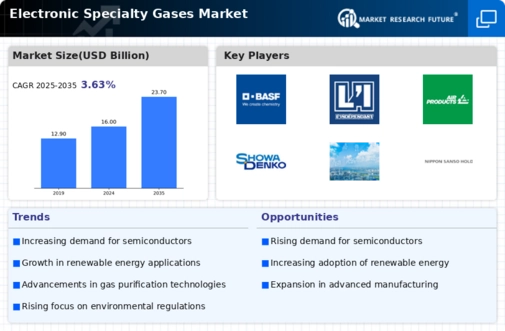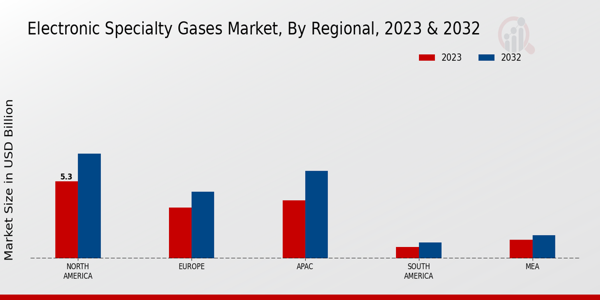Market Growth Projections
The Global Electronic Specialty Gases Market Industry is projected to grow significantly over the next decade. In 2024, the market is estimated at 16.0 USD Billion and is expected to reach 23.7 USD Billion by 2035. This growth trajectory indicates a compound annual growth rate (CAGR) of 3.63% from 2025 to 2035. Such projections highlight the increasing importance of specialty gases in various applications, including semiconductor manufacturing, renewable energy technologies, and advanced electronics. The anticipated growth underscores the need for continuous innovation and adaptation within the industry to meet evolving market demands.
Rising Demand for Semiconductors
The Global Electronic Specialty Gases Market Industry is experiencing a surge in demand driven by the semiconductor sector. As technology advances, the need for high-purity gases used in semiconductor manufacturing processes becomes increasingly critical. In 2024, the market is projected to reach 16.0 USD Billion, reflecting the industry's growth as manufacturers strive to meet the rising demand for smaller, faster, and more efficient electronic devices. The semiconductor industry's expansion, particularly in regions like Asia-Pacific, is likely to further bolster the demand for specialty gases, which are essential for etching, cleaning, and deposition processes.
Emerging Applications in Electronics
Emerging applications in the electronics sector are propelling the Global Electronic Specialty Gases Market Industry forward. New technologies, such as flexible electronics, wearable devices, and Internet of Things (IoT) applications, require specialized gases for their production processes. These applications often demand unique gas compositions to achieve desired material properties and performance characteristics. As these technologies gain traction, the demand for electronic specialty gases is expected to rise, further contributing to the market's expansion. The ability of these gases to meet the specific needs of innovative applications positions them as essential components in the evolving electronics landscape.
Growth in Renewable Energy Technologies
The Global Electronic Specialty Gases Market Industry is also influenced by the growth of renewable energy technologies. As the world shifts towards sustainable energy sources, the demand for electronic specialty gases used in solar panel manufacturing and wind turbine production is expected to rise. These gases play a crucial role in the fabrication of photovoltaic cells and other components. The increasing investment in renewable energy infrastructure globally suggests a robust future for the market, potentially contributing to the projected growth from 16.0 USD Billion in 2024 to 23.7 USD Billion by 2035, with a CAGR of 3.63% from 2025 to 2035.
Advancements in Electronics Manufacturing
Technological advancements in electronics manufacturing are a significant driver for the Global Electronic Specialty Gases Market Industry. Innovations in production techniques, such as atomic layer deposition and chemical vapor deposition, require high-purity specialty gases to ensure product quality and performance. As manufacturers adopt these advanced techniques to enhance efficiency and reduce costs, the demand for specialty gases is likely to increase. This trend is particularly evident in the production of advanced materials for consumer electronics, which are becoming more complex and require precise gas compositions for optimal performance.
Regulatory Compliance and Safety Standards
The Global Electronic Specialty Gases Market Industry is shaped by stringent regulatory compliance and safety standards. Governments worldwide are implementing regulations to ensure the safe handling and use of specialty gases, particularly those that are hazardous. Compliance with these regulations necessitates the use of high-quality gases, which can drive demand in the market. Companies are increasingly investing in technologies and processes that meet these safety standards, thereby influencing their purchasing decisions. This focus on safety and compliance is likely to sustain the market's growth as manufacturers prioritize the use of specialty gases that adhere to regulatory requirements.














